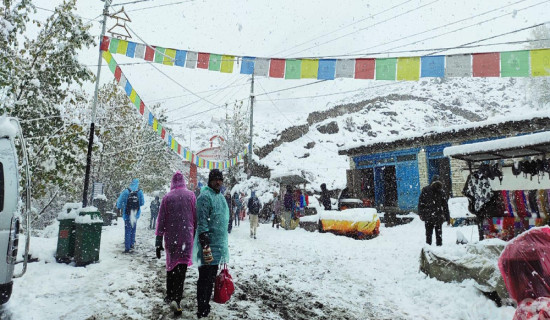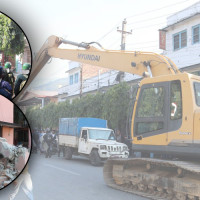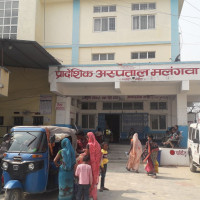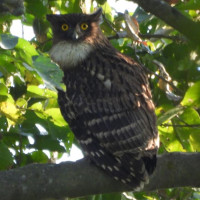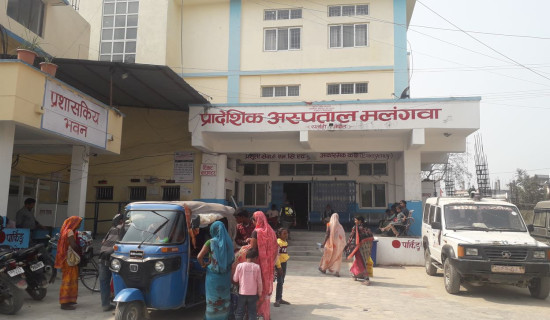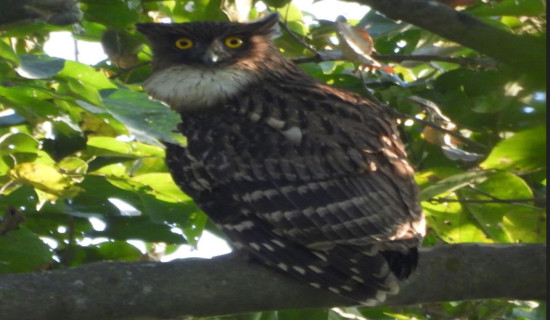- Saturday, 6 December 2025
Drones, AI And Precision Farming
Agriculture is a way of life for Nepali people, with 60 per cent population engaged in agriculture, contributing around 24 per cent to the national GDP (MOALD 2023). Despite being an agrarian country, Nepal still struggles to meet its agricultural demand due to subsistence farming practices and reliance on traditional technology. Rapid population growth has increased the demand for food and shelter, putting immense pressure on the land’s carrying capacity. As the population continues to rise, the need for modern, efficient, and sustainable agricultural practices becomes more urgent. Thus, the role of modern technology is significant in agricultural development.
There remains a wide technological gap between Nepal and developed countries in agricultural practices. While developed nations have adopted advanced machinery and precision agriculture to enhance productivity, Nepal continues to face challenges such as fragmented landholdings, poor infrastructure, and limited mechanization. Human and animal power still account for the majority of farm work. Although Nepal shifted from oxen to tractors in the 1970s, the use of advanced tools like drones has only recently been introduced. The country’s hilly and mountainous terrain, with narrow and sloping fields, makes the operation of large machines difficult.
Agricultural mechanization was long neglected, but it has now become a topic of discussion in Nepal. The former minister for Agriculture and Livestock Development, Padma Kumari Aryal once stated, “Through the modernization, commercialization, and mechanization of the agriculture sector, the government could realize the motto of ‘Prosperous Nepal, Happy Nepali.’”
Modern agriculture is undergoing technological revolutions driven by innovations such as drones, AI and precision agriculture. These technologies make farming more efficient, productive and sustainable practice.
Drones have become a powerful tool for farmers, as they provide real-time imagery to detect crop stress, disease, pest infestations, and growth patterns. Drones are equipped with sprayers to apply fertilizers, herbicides, and pesticides precisely, reducing chemical use. They provide 3D maps of fields, which aid in analyzing soil conditions, planning planting patterns, and managing the overall field. Similarly, drones can assess soil moisture levels and identify dry areas using thermal cameras, helping farmers adjust irrigation for better water conservation and healthier crops.
Additionally, drones are playing crucial role in enhancing weather forecasting and assessing environmental impacts in agriculture. Accurate weather data is vital for farmers to make decisions about planting, irrigation and harvesting.
AI plays a vital role in modern agriculture by enabling more efficient, productive and sustainable farming practices through data-driven insights and automation. AI supports farmers in addressing global challenges such as climate change, resource scarcity, and labour shortages. AI-powered computer vision and drone monitoring systems can detect early signs of plant disease, pest infestation and stress before they are visible to the human eye. This allows for targeted, timely intervention, reducing crop loss and minimizing the need for broad-spectrum pesticide application. AI can also differentiate between crops and weeds, enabling automated robots and sprayers to precisely target and eliminate weeds. This targeted approach reduces herbicide use by as much as 90 per cent.
Furthermore, AI and computer vision monitor livestock behaviour, movement, body temperature and eating patterns via drones and cameras. This technology can alert farmers to early signs of illness or stress, improving animal welfare and productivity. Similarly, AI helps farmers improve milk and egg production by monitoring feed consumption and other health indicators.
Precision farming plays a crucial role in modern agriculture by using technologies like GPS, sensors and AI to collect and analyze data for more efficient and sustainable farming. It enables farmers to apply resources precisely where and when they are needed, such as using variable rate technology to adjust fertilizer and water application based on soil conditions. This minimizes waste, reduces costs, and promotes environmental sustainability.
The “5Rs” of precision farming are Right Rate, Right Time, Right Input, Right Place, and Right Manner. This framework guides farmers in optimizing the application of inputs like fertilizers, and pesticides to improve efficiency, increase crop yields and reduce environmental impact by using technology to apply the correct amount of input in the correct manner, at the correct location, and at the correct time.
The core technologies of precision farming are GPS, GIS, and VRT. GPS provides precise geolocation and mapping for field operations. GPS-guided machinery, such as tractors with auto-steer minimises overlapping passes, saving fuel and time.
Precision agriculture is key to increasing food production and minimizing resource exploitation. Therefore, the integration of drones, AI and precision agriculture is revolutionizing how farmers manage crops and resources. These technologies empower data-driven decisions, improve efficiency, increase yields, and support environmental sustainability.
These smart farming tools will play a crucial role in ensuring food security and agricultural resilience. Nepal lags behind in the application of such modern technology due to inadequate infrastructure, financial constraints, and a shortage technical expertise. However, Nepal has begun applying drones, AI, and precision farming especially in pilot projects, NGOs, and some commercial farms, as well as through apps and sensor systems. But it is not yet deeply pervasive. If Nepal embraces the shift towards the application of modern technology, it can transform agriculture from a subsistence activity into a modern, commercial, tech-driven industry, bringing widespread social, economic, and environmental benefits.
(Khanal is BSc. 5th Semester student at Lamjung Campus, Sundarbajar.)



